This past year we have been experimenting with selling electronically distributed products, namely our iOS applications ‘State Lines‘ and ‘Coverage?‘, and our ‘Answers to Common Excuses‘ eBook.
We thought it would be interesting to share the hard numbers behind these roll-outs, because there isn’t a lot of real-world publicly available data showing the realities of how much (or little) independent developers and eBook publishers make.
We took on these projects as experiments in both learning new technologies and learning how to best distribute them.
In the case of our iPhone/iPad apps, we built product ideas that solved real world problems we had as full time travelers. We wrote apps that we wanted for ourselves, and that we could have fun developing. Fortunately (as you will see), we aren’t dependent on ‘making a living’ doing this – our core custom software development clients and projects happily remain our primary sources of income.
We share this information with you not to complain, but because so many folks ask us if creating and selling eProducts can be a profitable and sustainable business model. And we encounter a lot of folks who assume anyone who creates an iPhone app is destined to be an instant millionaire. As if…
So here we go:
State Lines for iPhone
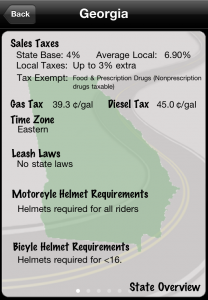 State Lines is the first iPhone app we developed – it is a handy guide to the state laws and regulations that change as you cross state lines, helping travelers keep up with seat belt laws, towing regulations, smoking bans, sales taxes, driving laws and much much more. We created this app because this was stuff we were always looking up, and we wanted to have it easily accessible in one convenient spot.
State Lines is the first iPhone app we developed – it is a handy guide to the state laws and regulations that change as you cross state lines, helping travelers keep up with seat belt laws, towing regulations, smoking bans, sales taxes, driving laws and much much more. We created this app because this was stuff we were always looking up, and we wanted to have it easily accessible in one convenient spot.
We began learning the specifics of iPhone development and working on State Lines in February of 2010, and officially launched it in early May 2010.
Our time invested into the initial launch of this app included:
Research on laws/regulations: ~70 hrs
Development time: ~100 hrs
Graphics & Initial Marketing: ~20 hrs
While we actually spent much more time than this developing State Lines, we’re estimating low because there was a lot of learning and experimentation time involved.
We have have also released three updates to expand State Lines and keep the app current, as well as a version of State Lines focused on alcohol laws, and the time spent on those versions and updates is not accounted for in these estimates either.
Now, the sales figures:
# of copies sold in 2010: 1161
Money earned: $2,152.80
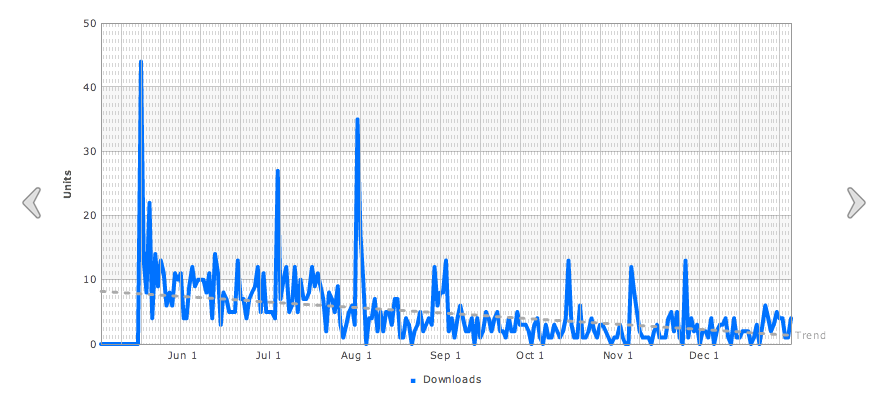
State Lines did reasonably well in the first month or two – having an average of about 15 downloads a day. But towards the end of the year, it slowed to a steady trickle of 2-3 copies a day. Overall, we averaged selling only 5 copies a day in 2010. From talking with other independent developers, this seems fairly typical.
If we consider just our initial pre-launch invested creation time, we’ve been compensated at about $11.33/hr. While this makes for a nice residual income, we won’t be quitting our day jobs anytime soon (not that we are aiming to).
We are however still working on evolving State Lines, and soon we’ll re-launch it as a universal iPhone/iPad version, as well as releasing the underlying data in an eBook format for those not on an iOS device.
As for pricing – you can purchase ‘State Lines‘ for $2.99, though we intend to up the price to $4.99 once the iPad version is released.
Coverage? for iPhone/iPad
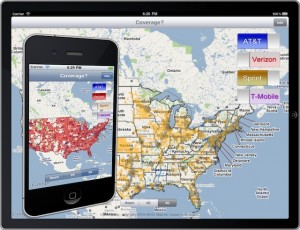 ‘Coverage?‘ is a universal iPhone/iPad app that provides an at-a-glance “universal” coverage map by interactively overlaying maps from the four major nationwide cellular providers. It isn’t meant to give neighborhood level detail, but rather it is a tool for us traveling bandwidth junkies to interactively see where we’re most likely to catch our next hit of usable bandwidth.
‘Coverage?‘ is a universal iPhone/iPad app that provides an at-a-glance “universal” coverage map by interactively overlaying maps from the four major nationwide cellular providers. It isn’t meant to give neighborhood level detail, but rather it is a tool for us traveling bandwidth junkies to interactively see where we’re most likely to catch our next hit of usable bandwidth.
We wrote this app not to embarrass AT&T or to make Verizon look good, but because as full time travelers, we needed it. To learn more about the story behind ‘Coverage?’, watch the demo video here.
Creating ‘Coverage?’ involved a whole raft of new technical challenges (excuse us as we geek a bit), in particular mastering the new in iOS 4.0 API’s for overlaying image layers on top of an underlying map. Being able to display so many graphical overlays interactively on top of Google Maps is pretty challenging stuff. We needed to learn more about digital cartography, map projections, tiling, and image compression than we ever imagined.
We also quickly learned that there’s a reason that a resource like ‘Coverage?’ doesn’t currently exist anywhere else – coverage map data is not easy to acquire. Each cell phone provider reports it through a very awkward interface, rendered in very different mapping formats and projections. It isn’t as simple as downloading maps and overlaying them – we had to first create our own interpretative maps based on each provider’s reports, standardize them to the same format, and separate out each coverage type to its own layer so that they could be compared on top of each other.
Our time invested in this project thus far:
Development time: ~200 hrs
Map creation: ~150 hrs
Graphics & Initial Marketing: ~20 hrs
We’re of course not including all of the research and learning time necessary to even take on creating ‘Coverage?’. Plus, in addition to investing our time, we outsourced some of the graphical map-making grunt work for a cost of $300. And that overhead cost will be repeated with each map update.
Since we just launched ‘Coverage?’ on December 22 – it’s far too soon to know what the longer term potential is of the project. But after the terrific launch-day numbers, the initial sales aren’t nearly as exciting as we hoped.
For the tail end of 2010, here are our results:
# of copies sold in 2010: 875
Money earned: $620.00
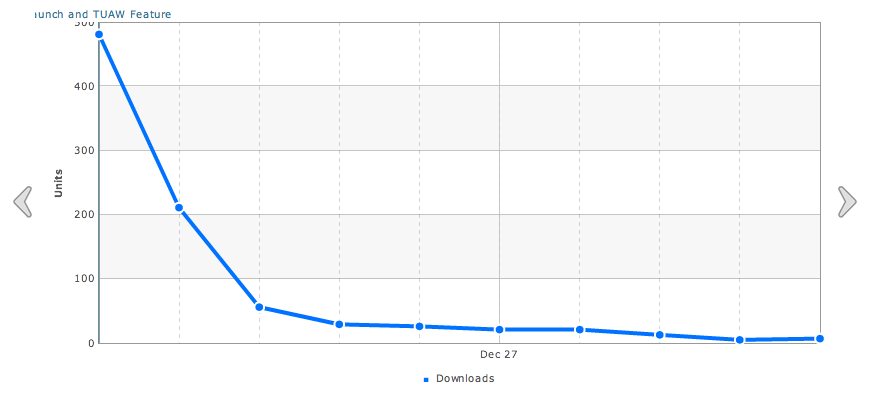
Our initial launch was quite exciting, and after a prominent featured review on TUAW we were blown away to sell 480 copies of ‘Coverage?’ on the first day. We immediately shot up as high as #2 in the iPad Navigation charts, and #3 on the overall iOS Navigation charts.
And then (we did know this was coming) Apple shut closed the interface to track sales for a week-long holiday shutdown, leaving us in limbo waiting for our next update on how well we were doing.
Based upon the day one sales, we thought we might have enough momentum to become an App Store success story, and we even had fantasies of ‘Coverage?’ earning us enough to buy a sailboat!
However, once Apple’s tracking interface came back online after the holidays, we were greatly disappointed to see the download numbers had quickly slumped off to about around 10 copies a day, and we were already nearly invisible in the App Store charts.
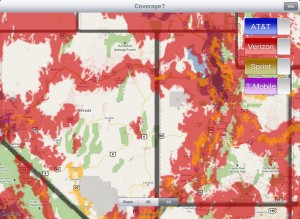 In hindsight, our biggest launch mistake was going with a 99-cent introductory price. While this made ‘Coverage?’ a no-brainer purchase, it also meant that we had a few too many ‘no brainer’ App Store reviews submitted by people who bought the app having not read the app description and who expected it to do things that it was explicitly not designed to do.
In hindsight, our biggest launch mistake was going with a 99-cent introductory price. While this made ‘Coverage?’ a no-brainer purchase, it also meant that we had a few too many ‘no brainer’ App Store reviews submitted by people who bought the app having not read the app description and who expected it to do things that it was explicitly not designed to do.
We’ve since raised the price of ‘Coverage?’ to $1.99, and we’ve found that a higher price makes for happier customers. Why? Because when spending more, people are much more likely to read reviews and the description to make sure the app is in line with their needs and expectations before purchasing. Since switching to $1.99, our sales have only slightly dropped, the reviews have improved, and our revenue has remained constant.
It is still way too early to draw too many conclusions from the launch of ‘Coverage?’. We still have a lot of media outreach to do to make sure that the app gets the notice it deserves, and we are working to make that happen. We are also playing around with some other business models – such as maybe offering a free version with limited features that can be upgraded via in-app-purchase.
But based upon our initial sales, we have a long ways to go to get to a break even point, especially since we are faced with recurring hard cash expenditures to keep the maps updated.
Answers to Common Excuses eBook
 When we were accepted to present at SXSW 2011 on Technomadism this coming March, we decided it was a good opportunity to experiment with offering a way for our readers to opt into financially supporting our non-commercial efforts in educating people about the potential and practicalities of this sort of lifestyle. Our ‘Answers to the Common Excuses’ blog series seemed like great content make into an eBook for fundraising.
When we were accepted to present at SXSW 2011 on Technomadism this coming March, we decided it was a good opportunity to experiment with offering a way for our readers to opt into financially supporting our non-commercial efforts in educating people about the potential and practicalities of this sort of lifestyle. Our ‘Answers to the Common Excuses’ blog series seemed like great content make into an eBook for fundraising.
We decided to release the eBook on a ‘Pay as you Wish‘ basis with a $20 suggested contribution, so that folks could decide what it was worth to them, and how much they’d like to support us.
Our time into this project thus far:
eBook Creation and Editing: ~40 hrs
Marketing graphics and materials: ~15 hrs
Obviously, we’re not including the time invested in writing the original blog posts that this eBook was based upon, just the time invested in re-writing, expanding and updating the content – and putting it into an eBook format.
Thus far, the eBook has these numbers:
# of copies downloaded in 2010: 156
# of folks who opted to contribute something: 38
Money raised (minus PayPal fees): $421.43
Average contribution per copy sold: $11.09
Average contribution per copy downloaded: $2.70
We’re quite thrilled with the generosity of folks choosing to contribute for their download of our eBook, and contributions have ranged from $1 – $40 (wow!). And we have hopes that some of the folks who opted to take our offer to preview the book for free will eventually come back and contribute.
Considering we weren’t launching the eBook to make a profit but simply offset our SXSW travel expense, we’re pretty darn happy that we’ve covered one plane ticket to SXSW so far. And we still have a couple months to go.
Some Analysis & Opinions
We’ve learned a few things with our eProduct experiments in 2010:
- We are glad that we spent our time developing things that we’re passionate about, proud of, and that we can use ourselves. If we had approached these projects as ‘work’, the return on our investment would have been exceedingly disappointing.
- If you build it, customers wont magically come. Creating content or an app is not enough – you must have a way to reach your audience. For any hope of success, you have to work constantly at keeping your visibility up! Particularly in the iOS App Store, it is really easy to get lost in amongst the other hundreds of thousands of apps.
- We’ve had several requests to port ‘State Lines’ and ‘Coverage?’ to other platforms, such as Android, Blackberry or WebOS. Based upon our results in the iOS App Store and research into the viability of these other marketplaces, we just can’t see any way that investing in these ports would be at all worth our time, or even any fun. We would need to buy phones, subscribe to data plans (and get locked into contracts), learn new languages and tools, and then do a bunch of drudge work – all to enter into a market where other developers report seeing only a fraction of the sales as they do on iOS. It seems that the majority of successful Android apps are advertising supported, a model that we are not fond of and which does not mesh well with occasional use reference apps like we have created. We remain open to partnering with other developers who want to take on the porting costs and split the profits, but we’re just not interested in investing time or money into it ourselves. Maybe once Amazon’s upcoming Android App Store launches, the market conditions will change…
- For niche focused useful apps like ours, selling at 99-cents just isn’t worth it. It is frustrating to be selling into a market where people value your work less than a can of soda, or a pack of chewing gum. In theory we can make it up in volume, but the volume for anything other than a mass-appealing hit just isn’t there. Selling cheaply devalues the work that went into creating the app, and invites critics not aligned with your app to submit unfounded negative reviews. For 2011 we are going to avoid under-pricing our apps, and are vowing to support other developers by buying their apps when the are OFF sale.
- If you are going to be in the App Store, it helps to have a thick skin. Consumers that spend a buck on your product seem to be the harshest critics, and they have very high expectations for their 99 cents. The App Store review system is completely one-sided towards the consumer’s voice; they can leave unfounded negativity anonymously and without any responsibility for what they say. And Apple gives developer’s absolutely no way to proactively provide customer service or even a refund to these people. In our opinion, the customer service side of the App Store if fundamentally broken.
Anyway – that’s been our experience with ‘State Lines‘ and ‘Coverage?‘, and our ‘Answers to Common Excuses‘ eBook. We thoroughly appreciate all of you who have supported us with purchases, positive reviews and spreading the word. Thank you!

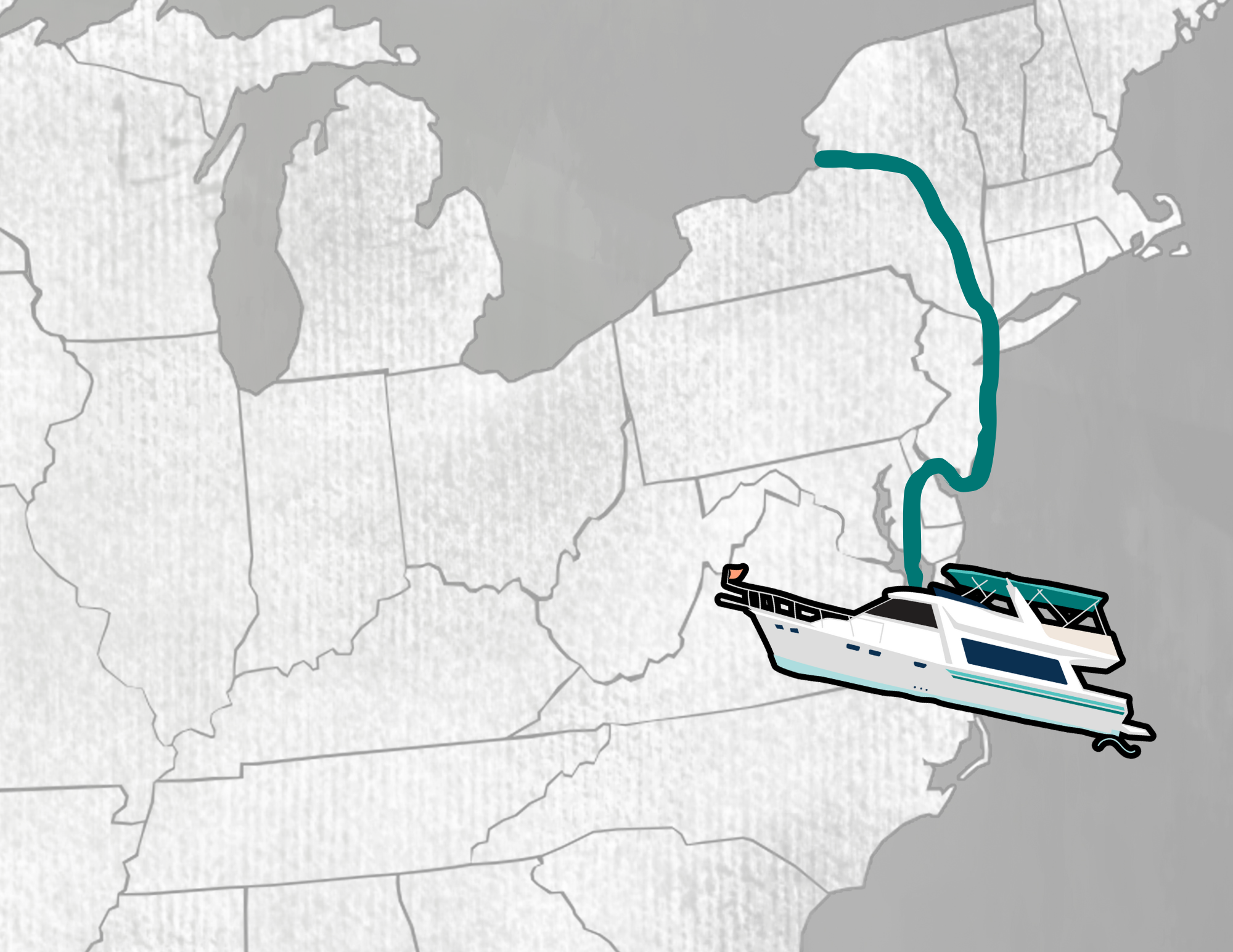
Any chance you would be interested in helping our cat rescue group develop a game app for a fundraiser? We’re also interested in a Facebook game app. We have a great idea (and huge following of cat lovers), but lack the technical ability to create it. Thanks for any feedback!
Hi Yvonne… sounds like a great organization. We have zero experience in game development, so we’re probably not your ideal developer. But we do offer consultation services to help you find the right development team and can even help you manage them to keep the project on track. Let us know if that might be of interest.
Interesting reading about your electronic marketing. How did you go about selling your products and how did you find and funnel your prospects to you?
Thanks for this! As we embark on our RTW expedition its MY job to figure out our revenue model while traveling worldwide. It’s pretty much my full time job outside of my full time job. Like you, we’ve got skills – its just a matter of figuring out the right way to deploy them.
I think your sales are respectable. You have to remember your target market is extremely small i.e. tech savvy nomands which is a very minuscule percentage of the population. The population of the US is 307 million at this time. How many of those people travel by road a great majority of the time and also use Apple apps; not very many. So again I think your sales are very respectable. You’re having fun, creating things that have never existed before and making some money helping to improve the journeys of others. Not bad…
For sure .. the focus has been on having fun and creating really useful tools that solve needs we, and others like us, have. It wouldn’t be worth doing if it wasn’t :). We realize we’re in a niche market – which is also why the 99-cent price point just doesn’t make sense.
However, Coverage? in particular has a wider reach than just us techy Apple nomads. While still not a general population tool, it does have a lot of potential to a wider market of folks. And we are gaining sales in these past weeks due to some features on Gizmodo, Lifehacker and more. It’s useful for anyone who travels and needs to keep connected – business travelers, photographers, hikers, campers, vacationers, etc.
And while money isn’t everything, it sure would be nice to at least have the projects fund themselves so we can continue to sustain them.
I am a very cheap person, I rarely by apps for my iPhone. Of the for apps that I have bought two of them are State Lines, and Coverage?. Because I am a fulltime RVer, these two apps address questions that are foremost in my mind when on the road, various different laws as I cross into a new state, and will I have coverage where I plan to stop for the night. Thank you for developing these two VERY helpful apps and continuing to update them as needed.
John Pontsler
Thank you.. we are flattered that our apps made your short list
Very useful post. Thanks for making it! I had wondered about the smart phone development market. I don’t play with smart phones. I just have a crappy pre-paid cheap phone (with browsing). I have smart computers instead (so I’m still old school) :). App development is really the only reason I could see to bite that bullet and spring for the extra bills and contracts.
Looked at those Millenicom plans as well. I have a grandfathered Sprint account that I’m fairly happy with (it would be hard to part with it). I’ve had some coverage trouble with it, but not much. Often coverage trouble is just a reason to throw the netbook in the scooter and take a fun scoot ride.
anyway, thanks for news on the app development.
travelfables
We had a grandfathered Sprint account too, was great – until they started enforcing roaming caps of 300 MB/ mo. They roam more often than you realize, and 300 mb can easily be a day’s use for us. Without any warning that we were even roaming, they completely shut down roaming on us when we hit the cap. That was our reason for switching to Millenicom – as we had no other choice to get online for hundreds of miles in any direction, and they could get us up and running same day with our existing equipment, with no roaming data caps.
Wow, haven’t experienced the enforced cap yet. I usually lock my hardware onto use sprint only, and unlock it when I need to roam (yet that roaming limit would put my teeth on edge as well). Not doing the full-timing RV run-amok thing as much as I use-to recently (hope to get back to it soon), and most of my recent stuff has been on network. Its good to know that I may have some problems ahead.
No one ever really writes about this side of business things, so it’s very helpful to hear your experiences! I had never even thought about the difference between selling an app for .99 vs 1.99 and how that would affect the user’s relationship to the product and their potential overall satisfaction. Thanks for sharing the info!
I love what this guy says and shares about his experience w/ apps. Don’t just skim these articles, lots of interesting analysis of what happened when he started giving away the app for free and getting all his sales from in-app purchases! (the titles alone tell you something)
http://gamesfromwithin.com/making-a-living-barely-on-the-iphone-app-store
http://gamesfromwithin.com/making-a-living-comfortably-on-the-app-store
http://gamesfromwithin.com/the-power-of-free
Interesting to see what happened when it added in an iPad version. He also mentions ‘fixing’ bad reviews by issuing an update.
I will admit here that I have not yet downloaded any of your apps, partly because I’m trying to figure out which phone or device we will take on the road, and which app or apps will help us the most. I can see us using a combination of iPad 3G and Sprint card w/ Millenicom for about six months in the U.S. before heading overseas. OK, forget it, I’m buying Coverage? for sure LOL I’ll look at State Lines more shortly.
Not sure how you could incorporate in-app purchases w/ free apps but it seems to be a powerful model. Just throwing that out there for you guys. I really hate to see such hard work and great apps not reach excellent levels of success!
Thank you so much for these links, I’m reading over them!
We had already been scheming up an In-App-Purchase model even before we started development.. and this just reinforces that it’s a good approach to try next. We have several ideas for it Stay tuned…
Stay tuned…
The iPad 3G and Millenicom options, by the way, would be a route we would definitely recommend. Not having a contract with either gives you a lot of flexibility to ditch them when you head overseas. And, in our experience (AT&T and Sprint are our two providers), the combined coverage is pretty darn good for most places.
thanks for the feedback Cherie! Very helpful info.
And if you want even better odds of getting a fast connection as your travel, you can get a Verizon card through Millenicom instead.
And Verizon’s Millenicom plan allows for twice the data usage as you get going directly with Verizon.
Chris, I thought the two lower Millenicom plans were through Verizon and the unlimited were through Sprint? Oh, wait – you are saying that Verizon has better coverage? Huh. Good thing I got this new iPhone app! lol
So I can get as much as a 20GB/month plan through a Verizon card, right?
Millenicom offers two plans:
Verizon – 10GB hard cap (which is twice what you can through Verizon directly) for $59.99/mo (no extra taxes, etc).
Sprint – ‘Don’t go over twice 10GB per month too often’ (ie. fuzzy 20GB/mo) for $69.99/mo.
Sprint often roams to Verizon towers, and since you’re not subject to roaming caps via Millenicom – if you need more GBs per month, the Sprint open can be a very good choice over hard data caps. But if 10GB is fine, then the Verizon plan will get you connected faster in more places.
looks like right now the cap is 20GB – possibly a promotion…and there is an unlimited plan (which mentions 50GB as a potential cap) – $59.99/mo – is that one Sprint? Not sure. Plus a plan if you have your own device. Could have sworn there was one more plan on their last week.
They seem to change things up as they have buying power. Last time we shopped them was back in August, and we’re not currently using them as Sprint & Verizon don’t work too well in the USVI. (For once.. hooray AT&T!) We had the Sprint BYOA plan for $69.99 with a fuzzy 20GB cap.
Their customer support is top notch – don’t hesitate to contact them with any questions you have. They were most helpful in helping us select the right plan for our needs.
Millenicom upped the cap of advanced (verizon) to 20gb and unlimited’s (sprint) soft cap to 50gb. Durring January, they have a promotion where you get the usb stick free with the advanced plan (normally $99).
Sweet deals, indeed!
And no.. the apps aren’t in the Mac App Store yet, as it would require a rewrite as iOS app UI doesn’t translate to desktop apps. We are considering it, for sure, tho… and waiting to see what tools and standards might be adopted for converting iOS to desktop.
Strangely enough the App store says I already own State Lines. Well cool.
Great info! I have been wondering how these types of projects work out. I have to agree your type of a product is more of a niche item which requires a more targeted advertisement to the right people. Best of luck!
Thanks R&M – it’s definitely a tough market, but we’re determined to give our apps their best possible shot at success.
Hey guys; love your facebook posts about your travels.
On the customer service issue, I’m curious — can you put a feature into the app for customers to give feedback?
Cheers,
=Dave Andre
Hi Dave.. thanks for stopping by!
Yes, it is entirely possible to build in a feedback option within the app. What we’re doing currently is a link to contact us through with suggestions or problems encountered. And we do get some very appreciated contacts that way with suggestions we plan to implement. Customers who pro-actively outreach tend to be fans of your product, and make contact because they have a vested interested in seeing the product improve. We love them!
However, that doesn’t solve the problem of there being no way for developer’s to contact folks who choose to leave their suggestions in the form of an app review, or offering refunds to dissatisfied customers.